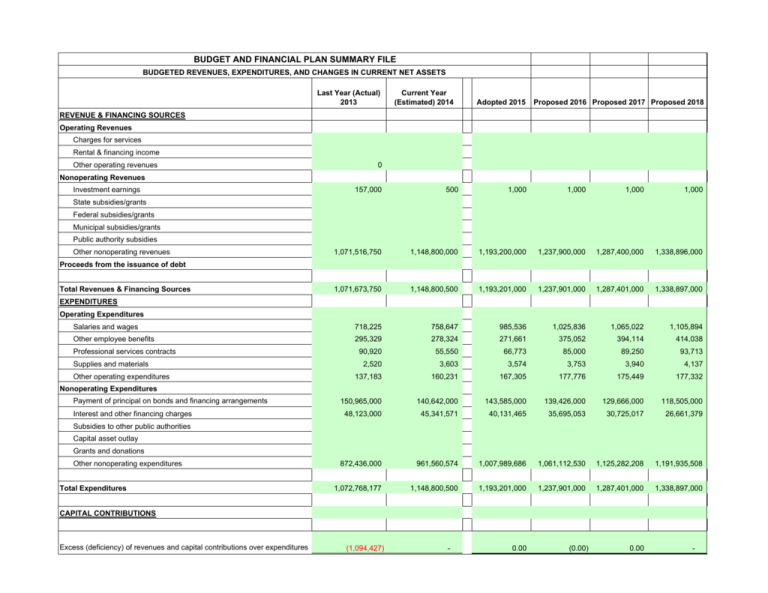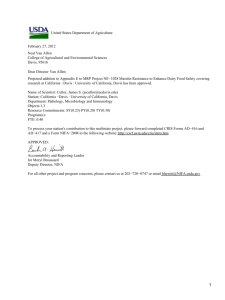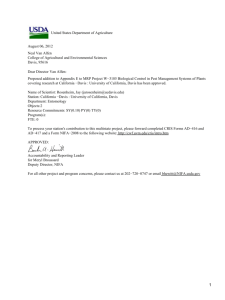2015-2018 Adopted Budget and Financial Plan
advertisement

BUDGET AND FINANCIAL PLAN SUMMARY FILE BUDGETED REVENUES, EXPENDITURES, AND CHANGES IN CURRENT NET ASSETS Last Year (Actual) 2013 Current Year (Estimated) 2014 Adopted 2015 Proposed 2016 Proposed 2017 Proposed 2018 REVENUE & FINANCING SOURCES Operating Revenues Charges for services Rental & financing income Other operating revenues 0 Nonoperating Revenues Investment earnings 157,000 500 1,000 1,000 1,000 1,000 1,071,516,750 1,148,800,000 1,193,200,000 1,237,900,000 1,287,400,000 1,338,896,000 1,071,673,750 1,148,800,500 1,193,201,000 1,237,901,000 1,287,401,000 1,338,897,000 Salaries and wages 718,225 758,647 985,536 1,025,836 1,065,022 1,105,894 Other employee benefits 295,329 278,324 271,661 375,052 394,114 414,038 90,920 55,550 66,773 85,000 89,250 93,713 2,520 3,603 3,574 3,753 3,940 4,137 137,183 160,231 167,305 177,776 175,449 177,332 150,965,000 140,642,000 143,585,000 139,426,000 129,666,000 118,505,000 48,123,000 45,341,571 40,131,465 35,695,053 30,725,017 26,661,379 872,436,000 961,560,574 1,007,989,686 1,061,112,530 1,125,282,208 1,191,935,508 1,072,768,177 1,148,800,500 1,193,201,000 1,237,901,000 1,287,401,000 1,338,897,000 State subsidies/grants Federal subsidies/grants Municipal subsidies/grants Public authority subsidies Other nonoperating revenues Proceeds from the issuance of debt Total Revenues & Financing Sources EXPENDITURES Operating Expenditures Professional services contracts Supplies and materials Other operating expenditures Nonoperating Expenditures Payment of principal on bonds and financing arrangements Interest and other financing charges Subsidies to other public authorities Capital asset outlay Grants and donations Other nonoperating expenditures Total Expenditures CAPITAL CONTRIBUTIONS Excess (deficiency) of revenues and capital contributions over expenditures (1,094,427) - 0.00 (0.00) 0.00 - NIFA Budget and Financial Plan 2015-2018 As of August 14, 2014 1. Accounting method: The budget has been prepared in accordance with GAAP using the modified accrual basis of accounting. 2. Assumptions and estimates used: The two largest items in the budget are; 1) sales tax revenue, taken from Nassau County’s Multi-Year Financial Plan Update for Fiscal Years 2014-2017; and 2) debt service, taken from the schedule of senior debt service provided in the NIFA Sales Tax Secured Bonds, Series 2012A and Series 2012B Bond Offering Circular. 3. Estimates of revenues: The main source of NIFA revenue is Nassau County sales tax. This projection has been taken from Nassau County’s Multi-Year Financial Plan Update for Fiscal Years 2014-2017. 4. Estimates of personal service expenses: The plan assumes that NIFA staffing levels will remain constant in accordance with guidance from the NIFA Employment and Compensation Committee. The budget assumes a 4% adjustment for salaries and a 7% increase in health insurance premiums in 2015. NIFA participates in the NYS pension plan and NYSHIP health insurance program. Pension costs were projected based on guidance from the State Comptroller at 18.8% of participating salaries for 2015 and projected at 18.8% for 2016-2018. One employee has opted for the new voluntary defined contribution plan and NIFA’s contribution is currently set at 8% of the participant’s salary. Salaries and fringe benefits were adjusted by 4% and 8%, respectively, in each year for 2016-2018. 5. Estimates of non-personal service expenses: Costs for office space, telephone, professional fees, and supplies were adjusted by a 5% inflation factor for each successive year of the plan. 6. Estimates of projected debt service expenditures: Projections for NIFA debt was taken from the schedule of senior debt service provided in the NIFA Sales Tax Secured Bonds, Series 2012A and Series 2012B Bond Offering Circular. Interest on variable rate bonds was calculated assuming that payments are equal to the receipts from the associated swaps. 7. Cash budget and financial plan: NIFA’s budgetary expenditures are closely aligned with the timing of its cash flow. There are no material timing differences other than receipt of sales tax and GAAP rules for debt service, which is explained below in item 18. 8. Explanation of relationship with units of government on whose behalf the authority was established: NIFA was created in 2000 for the purpose of overseeing the fiscal turnaround of Nassau County, issuance and administration of debt on behalf of the County, issuance of reports on statutory findings based on the County’s financial condition, and for the disbursement of State assistance. 9. Description of budget process and key budget decisions: The budget is created by the NIFA Treasurer and reviewed by its Executive Director and Audit and Internal Controls Committee. It is then approved by the NIFA Directors prior to the start of each fiscal year. Staffing level decisions are guided by recommendations of the NIFA Employment and Compensation Committee. 10. Description of budget assumptions including revenue sources, staffing etc: Revenues of the Authority (“Revenues”) consist of sales tax revenues, defined as net collections from sales and compensating use taxes, penalties and interest authorized by the State and imposed by the County on the sale and use of tangible personal property and services in the County (“Sales Tax Revenues”), and investment earnings on money and investments on deposit in various Authority accounts. Sales Tax Revenues collected by the State Comptroller for transfer to the Authority are not subject to appropriation by the State or County. Revenues of the Authority that are not required to pay debt service, operating expenses and other costs of the Authority are payable to the County as frequently as practicable. Revenue numbers used in the budget have been taken from Nassau County’s Updated Multi-Year Financial Plan for Fiscal Years 2015-2018. Staffing has been kept at the level required to perform appropriate oversight of the County and covered organizations including the Nassau County Health Care Corporation, Sewer and Storm Water Authority and Nassau Community College. 11. Self assessment of budget risks: NIFA has a perfected interest in the sales tax collections for Nassau County and receives remittances from the NYS Department of Taxation and Finance for the purpose of withholding debt service set-aside monies and expenses, prior to remittance to the County. NIFA’s costs are closely monitored by its executive staff and its Directors. As a result, there is little budget risk to NIFA or its bond holders. 12. Revised forecast of current year budget: The current year projected results for core operating expenses are anticipated to be less than the adopted budget. The Board had approved additional spending for litigation costs that have been incurred during the Control Period on Nassau County. These additional costs will be partially funded with savings from core operating expenses. 13. Reconciliation that identifies all changes in estimates from projections in the previously approved budget: There are no material revisions to the previously approved budget based on current projections. 14. Statement of last year’s fiscal actual performance: The 2013 fiscal performance and 2014 projected results are in substantial conformity with its approved budget. 15. Projections of number of employees, funding source, and functional classifications: NIFA currently operates with 5 full-time employees. Positions are funded via a withholding of sales tax proceeds which are received on behalf of Nassau County. These are classified as general operating expenses in the budget and financial statement. 16. Statement of revenue enhancing or cost reduction initiatives: NIFA has maintained a lean staffing plan in light of its debt issuance and oversight responsibilities. NIFA has also taken steps to reduce expenditures for rent, telephone and communications, and other expenses. The Authority oversees a $2.8 billion County budget and has issued approximately $4.0 billion of debt, including swap transactions, during the past 14 years. NIFA currently has outstanding approximately $1.228 billion in bonds, of which approximately $569 million are in the variable rate mode. 17. Statement on any non-recurring resource planned for use in any given year: Not applicable- in the past NIFA issued bonds on behalf of the County based on their requirements, however, NIFA is not planning to issue any new debt as of this writing. 18. Statement on transactions that shift resources from one year to another: Under GAAP reporting rules, NIFA accrues two months of sales tax revenue receivable at each calendar year end which will be paid in January and February of the subsequent year by the NYS Department of Taxation and Finance. However, also as per GAAP rules, NIFA accrues 12 months of debt service payments as a current liability. As a result, there is always a negative balance of current assets net of current liabilities, which directly results from this reporting timing difference. It should be noted that NIFA still has all funds required for its annual May 15 interest payment and annual November 15 principal and interest payments, under this scenario. 19. Statement on borrowed debt outstanding at year end, planned issuances, assumed interest rates, debt service as a percentage of pledged revenue: The final maturity of the outstanding bonds is November 15, 2025. NIFA’s statute requires it to remain in existence until all of its bonds have been paid or are no longer outstanding. No new debt is authorized in the NIFA Act except to refund existing debt. NIFA’s debt program was initiated in FY 2000 and continued successfully in 2013. The outstanding debt of $1.228 billion is comprised of $659,258,000 of conventional fixed rate debt, and $568,900,000 of synthetic fixed rate debt. Total estimated debt service to maturity was $1,464,895,000 as of December 31, 2013. NIFA does not have any notes outstanding. 20. Statement on capital budget plan: not applicable 21. Statement from COO on reasonableness of assumptions and estimates: I confirm, to the best of my knowledge and belief, the following representations made to you in this financial plan are fairly presented in conformity with accounting principles generally accepted in the United States of America. To the best of my knowledge and belief, after reasonable inquiry, the plan is based on reasonable assumptions and methods of estimation and that all regulations have been satisfied. _______________________ Carl A. Dreyer, Treasurer







